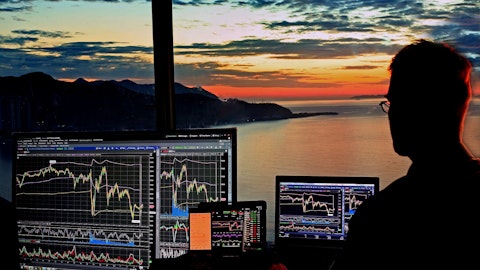In this article, we discuss 10 ETFs to buy and hold for the next 10 years. If you want to skip our detailed analysis of these exchange traded funds, go directly to 5 ETFs to Buy and Hold for the Next 10 Years.
Exchange traded funds are fast becoming a trade instrument of choice for investors as they navigate the stock market amid the Russian war on Ukraine. Todd Rosenbluth, a senior director of ETF and mutual fund research at CFRA Research, told CNBC in an interview on March 2 investors flock to ETFs when market volatility increases. Rosenbluth believes that one of the biggest advantages of ETF investing is that “you can get out when you want to, you can get in when you want to” unlike many other investment vehicles.
Investing in ETFs helps you diversify your portfolio and have stakes in long-term growth stocks like Microsoft Corporation (NASDAQ:MSFT), Alphabet Inc. (NASDAQ:GOOG), and Apple Inc. (NASDAQ:AAPL).

Our Methodology
After a careful assessment of the ETF market, we selected diverse funds with exposure to different market segments. We selected these ETFs with a long-term perspective in mind.
We have also mentioned the famous underlying stocks held by these exchange traded funds, so investors can understand the overall market exposure of each fund.
ETFs to Buy and Hold for the Next 10 Years
10. Invesco QQQ Trust (NASDAQ:QQQ)
Invesco QQQ Trust (NASDAQ:QQQ) is an ETF that tracks the biggest non-financial companies in the Nasdaq-100 Index. Invesco QQQ Trust (NASDAQ:QQQ) has consecutively outperformed the S&P 500 index since its inception in 1999, and the fund has demonstrated a growth of $10,000 as of December 31, 2021.
Invesco QQQ Trust (NASDAQ:QQQ) exposes investors to multiple innovative sectors such as augmented reality, cloud computing, big data, mobile payments, streaming services, and electric vehicles, among others. The largest underlying security in Invesco QQQ Trust (NASDAQ:QQQ)’s portfolio is Apple Inc. (NASDAQ:AAPL).
On March 9, Morgan Stanley analyst Katy Huberty said that Apple Inc. (NASDAQ:AAPL)’s latest launch event was in-line with her expectations, while it also highlighted the “continued output of Apple’s world-class innovation engine”. She kept an Overweight rating and a $210 price target on Apple Inc. (NASDAQ:AAPL) shares.
Elite hedge funds are extremely bullish on Apple Inc. (NASDAQ:AAPL). In the fourth quarter of 2021, 134 hedge funds reported owning stakes worth $186 billion in Apple Inc. (NASDAQ:AAPL), up from 120 funds in the previous quarter, holding stakes in Apple Inc. (NASDAQ:AAPL) valued at $146 billion. Berkshire Hathaway is the largest shareholder of the company, with a stake worth $157.5 billion.
Here is what Saturna Capital Amana Funds has to say about Apple Inc. (NASDAQ:AAPL) in its Q4 2021 investor letter:
“Concerning the stock market, we avoid short-term predictions. But what of the next decade? A theme since the start of the pandemic has been getting bigger. Apple Inc. (NASDAQ:AAPL) flirts with a $3 trillion market capitalization, trailed by Microsoft, as Alphabet and Amazon also appear among the top five largest companies.
While Apple Inc. (NASDAQ:AAPL) may not be a network in the traditional sense, it does have over one billion active users dedicated to its products. Apple Inc. (NASDAQ:AAPL) ’s unrivaled ability to integrate complex technology with a user-friendly customer experience positions the company to extend into media content, augmented reality, the connected home, and perhaps EVs, all while growing its profitable subscription revenue.”
9. Schwab U.S. Dividend Equity ETF (NYSE:SCHD)
Schwab U.S. Dividend Equity ETF (NYSE:SCHD) is an exchange traded fund that seeks to mirror the total return of the Dow Jones U.S. Dividend 100 Index. As of December 31, 2021, Schwab U.S. Dividend Equity ETF (NYSE:SCHD)’s market capitalization is $138.57 billion, with a return on equity of 31.40%.
The annualized 1-year returns of Schwab U.S. Dividend Equity ETF (NYSE:SCHD) tracked the benchmark returns closely. As of February 28, the 1-year annual return posted by Schwab U.S. Dividend Equity ETF (NYSE:SCHD) was 17.87%, whereas over the same period, the Dow Jones U.S. Dividend 100 Index returned 18%.
The portfolio is primarily concentrated in the financials, information technology, consumer staples, industrials, healthcare sectors. The most significant holding in Schwab U.S. Dividend Equity ETF (NYSE:SCHD)’s portfolio is Amgen Inc. (NASDAQ:AMGN), a company focused on human therapeutics, specializing in inflammation, oncology, hematology, bone health, cardiovascular disease, nephrology, and neuroscience.
On March 2, Amgen Inc. (NASDAQ:AMGN) declared a quarterly dividend of $1.94 per share, in line with previous. With a forward yield of 3.39%, the dividend is distributable on June 8, for shareholders of record on May 17.
In Q4 2021, 52 hedge funds in the database of Insider Monkey reported owning stakes worth $1.82 billion in Amgen Inc. (NASDAQ:AMGN). As of the close of the December quarter, Two Sigma Advisors is the largest stakeholder of Amgen Inc. (NASDAQ:AMGN), with 1.81 million shares worth approximately $407 million.
In addition to Microsoft Corporation (NASDAQ:MSFT), Alphabet Inc. (NASDAQ:GOOG), and Apple Inc. (NASDAQ:AAPL), Amgen Inc. (NASDAQ:AMGN) is a popular stock in the hedge fund universe.
Here is what ClearBridge Sustainability Leaders Strategy had to say about Amgen, Inc. (NASDAQ:AMGN) in its Q3 2021 investor letter:
“In health care, Amgen, Inc. (NASDAQ:AMGN) , a biotechnology company, has endured several pipeline setbacks recently, including a slow transition of its Lumakras treatment into first-line lung cancer, a slower than expected development of its treatment for myeloma as well as the company’s asthma treatment Tezepelumab missing its primary endpoint in a Phase III study. We remain positive on the stock, with Amgen’s investments in biosimilars and its pipeline part of our long-term thesis.”
8. Vanguard S&P 500 ETF (NYSE:VOO)
Vanguard S&P 500 ETF (NYSE:VOO) mirrors the returns of the S&P 500 Index, exposing investors to the biggest 500 US companies. Vanguard S&P 500 ETF (NYSE:VOO)’s 1-year annual returns as of December 31 came in at 28.66%, closely tracking the benchmark, which stood at 28.71%. The fund’s total net assets at the end of December 2021 were $816.6 billion, with the top ten holdings comprising 30.1% of the total portfolio.
A significant holding in Vanguard S&P 500 ETF (NYSE:VOO)’s latest portfolio is Alphabet Inc. (NASDAQ:GOOG), the parent company of Google and Google subsidiaries. On March 4, Alphabet Inc. (NASDAQ:GOOG) announced that it has stopped its advertising services in Russia, following in the steps of other digital ad sellers in the wake of Russia’s invasion of Ukraine. The ban covers its search products as well as YouTube and outside publishing partners.
Deutsche Bank analyst Ben Black initiated coverage of Alphabet Inc. (NASDAQ:GOOG) with a Buy rating and a $3,150 price target on March 10. According to the analyst, Alphabet Inc. (NASDAQ:GOOG) is a structural winner from the secular trend of commerce and services shifting from offline, physical venues to digital storefronts.
The fourth quarter database of Insider Monkey reported that 158 hedge funds were bullish on Alphabet Inc. (NASDAQ:GOOG), up from 156 funds in the quarter prior. The largest Alphabet Inc. (NASDAQ:GOOG) shareholder is TCI Fund Management, with approximately 3 million shares worth $8.5 billion.
Here is what Artisan Value Fund has to say about Alphabet Inc. (NASDAQ:GOOG) in its Q4 2021 investor letter:
“Overall top contributors (includes) Alphabet Inc. (NASDAQ:GOOG). Advertising is recovering, and Alphabet is a key beneficiary through its search business and online video business YouTube. We continue to see large profit pools for Alphabet in the early stages of monetization, along with the migration of advertising dollars away from traditional mediums, like TV, to online search and video. These factors give us confidence that Alphabet continues to have a long runway to grow revenue and profits. In addition, Alphabet’s cost controls are improving, which is driving more revenue growth to the bottom line. Finally, management has begun to aggressively return capital to shareholders, which we think is another lever that is increasing per share value of the business. We view Alphabet Inc. (NASDAQ:GOOG) as one of the best businesses in the world, capable of expanding revenues at a rapid rate for years to come, with a bulletproof balance sheet and an average asking price. It’s a name we’ve owned since 2012, and we believe Alphabet will continue to be a strong compounder of value in the future.”
7. iShares Core S&P Mid-Cap ETF (NYSE:IJH)
iShares Core S&P Mid-Cap ETF (NYSE:IJH) tracks the investment results of the S&P MidCap 400 Index, which holds mid-capitalization U.S. equities. As of March 10, the total net assets of iShares Core S&P Mid-Cap ETF (NYSE:IJH) equaled $63.5 billion, and the 1-year total return at the end of February 2022 was 7.90%, whereas the benchmark returned 7.98% over the same period.
A prominent security in iShares Core S&P Mid-Cap ETF (NYSE:IJH)’s portfolio is Builders FirstSource, Inc. (NYSE:BLDR), a company that manufactures and supplies building materials and construction services to professional homebuilders, contractors, remodelers, and consumers across the United States.
Builders FirstSource, Inc. (NYSE:BLDR) is a popular construction stock on Wall Street. In the fourth quarter of 2021, 59 elite hedge funds held long positions in Builders FirstSource, Inc. (NYSE:BLDR), up from 53 funds in the prior quarter. The total stakes held in Q4 were valued at $2.38 billion. Coliseum Capital is the leading stakeholder of the company, with 4.6 million shares worth $402.7 million.
Just like Microsoft Corporation (NASDAQ:MSFT), Alphabet Inc. (NASDAQ:GOOG), and Apple Inc. (NASDAQ:AAPL), Builders FirstSource, Inc. (NYSE:BLDR) is a notable stock on the radar of institutional investors.
Here is what Merion Road Capital Management has to say about Builders FirstSource, Inc. (NYSE:BLDR) in its Q3 2021 investor letter:
“I added to our position in Builders FirstSource (“BLDR”) during the quarter. BLDR is the largest national supplier of structural building products and value-added components to the residential construction market. They have been active in consolidating the industry, most notably with the merger of BMC earlier this year. Like other distributors, BLDR benefits from scale advantages that afford them a robust product offering, enhanced purchasing power, and fixed cost leverage. They will continue to acquire smaller competitors and have announced 5 new deals so far this year.
I view the strategic benefit of these acquisitions in three different buckets. There are the core tuck-in acquisitions of facilities and customer lists that increase scale and geographic reach. An example would be the company’s May acquisition of John’s Lumber, a lumber and specialty product distributor serving the Detroit MSA, at 0.5x revenue. There are product acquisitions that leverage their platform to increase distribution and improve the product offering. For instance, last month BLDR announced the acquisition of California TrusFrame, a designer and manufacturer of prefabricated components like trusses and wall panels, at 1.3x revenue. And lastly BLDR has begun investing in software and services. In June they spent $450mm on the purchase of WTS Paradigm, a software company that addresses the complexity around building configuration, estimating, and manufacturing, at 9.0x revenue. By utilizing software in the planning process, WTS Paradigm cuts down on material and labor waste, ensures an optimal fit of product and design, and eases the contractor’s workload. BLDR has followed this up with a much smaller software acquisition in September.
BLDR is in the very early innings of their software investment, so it is difficult to pinpoint exactly how it will impact the company in the coming years. Management believes that there is a lot of low hanging fruit, pointing to a McKinsey study ranking the construction industry as second to last on overall digitization. If anyone has had any work done to their house, I am sure they can anecdotally attest to this. BLDR plans to leverage WTS Paradigm to increase internal productivity (i.e. improved estimating leading to fewer visits to the job site), cross-sell the software to existing clients, and drive greater adoption of value-added products. So thinking a few years out I think the goal would be to have higher margins on their commodity business, a greater mix of revenue coming from value added products, a stronger relationship with their customer, and an enhanced competitive advantage…” (Click here to see the full text)
6. Vanguard Small-Cap Index Fund ETF Shares (NYSE:VB)
Vanguard Small-Cap Index Fund ETF Shares (NYSE:VB) uses a full-replication strategy to mirror the returns of the CRSP US Small Cap Index, which measures the investment return of small-capitalization stocks. Vanguard Small-Cap Index Fund ETF Shares (NYSE:VB) holds 1550 stocks in its portfolio as of January 31, with total net assets amounting to $129 billion. The fund on December 31 reported 1-year average annual returns of 17.72%, whereas the benchmark index returned 17.71%.
A prominent holding in Vanguard Small-Cap Index Fund ETF Shares (NYSE:VB)’s portfolio is Diamondback Energy, Inc. (NASDAQ:FANG), a Texas-based independent oil and natural gas company. The energy sector once again topped the S&P 500 index on March 10, even as crude oil futures fell more than 2%, extending the group’s year-to-date gains to 35% as investors focus on mounting inflation fears despite crude’s one-day reprieve.
Piper Sandler analyst Mark Lear on March 10 raised the price target on Diamondback Energy, Inc. (NASDAQ:FANG) to $163 from $142 and kept an Overweight rating on the shares. U.S. exploration and production companies have outperformed the broader market year-to-date, but the equities do not reflect the longer term oil and gas supply uncertainty in the wake of the Ukraine invasion, the analyst told investors in a bullish thesis.
Among the hedge funds tracked by Insider Monkey at the end of December 2021, 45 funds were long Diamondback Energy, Inc. (NASDAQ:FANG), with combined stakes amounting to $572.4 million. Harris Associates is the biggest Diamondback Energy, Inc. (NASDAQ:FANG) stakeholder as of Q4 2021, with more than 3 million shares worth almost $328 million.
Here is what Miller Opportunity Equity has to say about Diamondback Energy, Inc. (NASDAQ:FANG) in its Q4 2021 investor letter:
“Diamondback Energy (FANG) returned 14.4% in the quarter as oil price rose and fell during the quarter ending the period largely in the same place that it started. The company reported strong 3Q results beating on the top and bottom line. The company reported revenue of $1.9B beating consensus of $1.5B with EPS of $2.94 beating expectations for $2.79. The beat was driven by a combination of higher volumes, higher realizations, and efficiency gains. The company increased its total production guidance for the year to 370-372mboe/d1 (up from 363-370mboe/d) while lowering Capital Expenditure (CAPEX) guidance for the second time this year to $1.49-1.53B. The company raised the dividend for the third time this year to $2/share annually while authorizing a new $2B share repurchase program. Starting in 4Q21, the company plans to return 50% of Free Cash Flow to shareholders through the base dividend and a combination of buybacks and special dividends. Finally, the CEO Travis Stice announced plans to reduce methane emissions by 70% as part of the firm’s ESG initiative.”
Click to continue reading and see 5 ETFs to Buy and Hold for the Next 10 Years.
Suggested articles:
- 10 Best Undervalued Stocks According to Hedge Funds
- Housing Market Predictions for 2022 and 10 Stocks to Watch
- 10 Best Dow Dividend Stocks to Double Your Income
Disclosure: None. 10 ETFs to Buy and Hold for the Next 10 Years is originally published on Insider Monkey.




